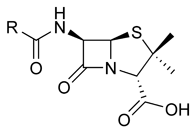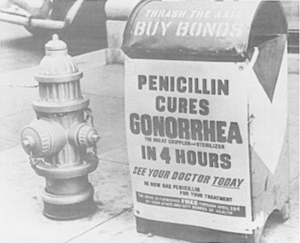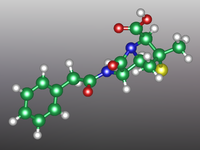In the winter of 1998-1999 an outbreak of pneumococcal pneumonia occurred among Ranger students undergoing high-intensity training. Thirty pneumonia cases (attack rate = 12.6%) were identified among a group of 239 students. Eighteen students were hospitalized; Streptococcus pneumoniae-- positive cultures were detected in 11 (61.1% of these 18 hospitalized cases. Pneumococci were also identified in throat swabs of 30 (13.6% of 221 nonhospitalized students surveyed. Serum antipneumolysin seroconversions were detected in 30 (18.3% of 164 students tested. An association between development of serum antipneumolysin antibody and pneumococcal pharyngeal carriage/colonization was found. Of 30 seroconverters, eight (26.7%) had S. pneumoniae-positive cultures compared with only 17 (12.7% of 134 nonseroconverters (relative risks = 2.02, 95% confidence interval = 1.02-4.02, p = 0.05). The outbreak was controlled by administrating low-- dose, oral azithromycin prophylaxis (250 mg weekly for 2 weeks) and was associated with a 69% reduction in pneumococcal carriage and a 94% reduction in pneumonia rates.
Introduction
Acute respiratory diseases (ARD) cause significant morbidity in military populations. Training and mobilization centers have traditionally been the foci of respiratory disease epidemics due to close living conditions, the physically and psychologically stressful activities, and a multitude of pathogens brought together by these troops.1,2 For more than five decades, mass antibiotic (penicillin or erythromycin) prophylaxis has been used with success to interrupt outbreaks, to prevent serious clinical sequelae of streptococcal and meningococcal infections, to reduce infection and nasopharyngeal carriage,3-6 and to minimize acute respiratory morbidity in general.7-9 Still, many military medical officers are reluctant to use mass antibiotic prophyla)ds, mainly due to concerns regarding side effects (e.g., allergic reactions), unintended consequences (e.g., antibiotic resistance), and costs. While these concerns are important, they must be weighed against the medical and military operational costs associated with recurrent outbreaks.7-10
In March 1991, in the aftermath of outbreaks of pneumococcal pneumonia and streptococcal pharyngitis, Ranger students at a U.S. military installation began to receive two doses of benzathine penicillin G (bicillin), 4 weeks apart, during their 9-week training cycle. In September 1997, the prophylaxis regimen was reduced to a single dose, and in March 1998, routine prophylaxis was discontinued altogether. Discontinuance of prophylaxis was made by unit medical authorities and was based on a perceived absence of cases and reduced risk of infection. Pneumonia quickly re-emerged as a problem among Ranger students, first in the spring of 1998 and then in the winter of 1998-1999 (Fig. 1). In this report, we describe the winter epidemic of 1998-1999 and discuss further recommendations to preclude future outbreaks.
Materials and Methods
General Description
The investigation consisted of: (1) an initial review of all medical histories and laboratory work of hospitalized cases, (2) review of all class (4-99) medical records since the beginning of training, (3) administration of a questionnaire to obtain demographic, training, and risk factor data, (4) collection of throat swabs for pathogen isolation, and (5) collection of initial (week 5) serum samples for antipneumolysin antibody determinations. At follow-up 4 weeks later at the end of training (week 9), the following were obtained: (1) subsequent case histories of upper and lower respiratory illness among class 4-99 graduates, (2) a second questionnaire, throat swab, and serum sample on all dropouts and recycles in the class, and (3) a questionnaire, throat swab, and serum sample for determination of end-of-- training cumulative illness rates, bacteriological pharyngeal carriage/colonization rates, and serum antipneumolysin titers.
Case Definitions
A case of ARD was defined as a respiratory illness presenting with an oral temperature of >= 100.5 deg F accompanied by one or more of the following signs or symptoms: sore throat, cough, rhinorrhea, nasal congestion, sinus tenderness, rates, rhonchi, or wheezing on auscultation. A pneumonia case was defined as any student who met one or more of the following criteria: (1) an oral temperature equal to or greater than 100.5 deg F with a positive sputum or blood culture or a positive chest X-ray diagnostic of a pneumonic process; (2) symptoms of productive cough and adventitious lung sounds on auscultation with or without a temperature equal to or greater than 100.5 deg F and with a white blood cell count (WBC) of 10,000 cells/mm^sup 3^ or greater; or (3) a throat or sputum culture positive for Streptococcus pneumoniae with at least one of the above two criteria. A carrier or colonized person was defined as an asymptomatic student with a positive throat culture for S. pneumoniae.
Throat Swab Cultures and Polymerase Chain Reaction Testing
Throat swabs for detection of Mycoplasma pneumoniae (by culture and polymerase chain reaction), Chlamydia pneumoniae (by polymerase chain reaction), and Streptococcus pyogenes/S. pneumoniae (by culture) were obtained on all new cases that had not received treatment. All throat swabs were sent by overnight courier to the Navy Respiratory Disease Laboratory, Naval Health Research Center, San Diego, California.
Serum Samples and Antibody Testing
Sera were obtained from all current members of class 4-99 during the initial evaluation (week 5 of training) and again 4 weeks later (week 9). As per previously published methods,11,12 paired sera were examined for evidence of acute infection with S. pyogenes (ASO, DNAse B) and C. pneumoniae (by microimmunofluorescence) at the Navy Respiratory Disease Laboratory. Paired sera were also examined for evidence of recent S. pneumoniae infection by immunoglobulin G and immunoglobulin M antipneumolysin determinations by enzyme-linked immunosorbent assay with the assistance of colleagues from the National Public Health Institute, Helsinki, Finland, following published procedures. 13,14 A twofold or higher rise in immunoglobulin G or immunoglobulin M antipneumolysin titers was considered evidence of recent infection.
Statistical Analysis
Overall rates of respiratory illness and pneumonia were calculated for the involved class. Also the proportion of individuals colonized with S. pneumoniae, the proportion of those who had subclinical infections, and the proportion of individuals that developed antibody seroconversions to S. pneumoniae was calculated. End-point markers (i.e., dependent variables) such as illness, carriage/colonization, and infection (i.e., seroconversion) rates were examined for potential associations with demographic, clinical, and exposure variables by tests of association such as the Chi^sup 2^ and Fisher's exact tests (Epi Info 2000, version 1.0, Atlanta, Georgia) and determination of relative risks (RR) and associated 95% confidence intervals (True Epistat version 5.3, Richardson, Texas).
Results
General Overview of Outbreak
A total of 326 students began Ranger training as class 4-99 on February 1, 1999; 239 (73.3%) of them were still present at the end of week 5 of training on March 5-9, 1999 when the initial outbreak investigation was conducted. This cohort consisted of men between the ages of 19 and 36 years (mean age = 24 years). Of these, 207 (86.6%) were Caucasian, 16 (6.7%) were Hispanic, 9 (3.8%) were African-American, and 7 (2.9%) were Asian. Officers accounted for 123 (51.5%) individuals in the cohort.
Medical Records Review
Acknowledgments
We would like to thank the line commanders and medical staff of the Ranger training brigade and 4th Ranger Training Battalion at Fort Benning, Georgia and at the 5th Ranger Training Battalion in Camp Merrill, Dahlonega, Georgia. We also extend our sincere appreciation to our colleagues at the National Public Health Institute, Helsinki, Finland, for their assistance in laboratory testing of specimens.
References
1. Gray GC: Acute respiratory disease in the military. Fed Practit 1995; 12: 27-33.
2. Gray GC, Callahan JD, Hawksworth AW, Fisher CA, Gaydos JC: Respiratory diseases among US military personnel: strategies to counter emerging threats. Emerg Infect Dis 1999; 5: 379-87.
3. Goerner JR, Massel BF, Jones TD: Use of penicillin in the treatment of carriers of beta-hemolytic streptococci among patients with rheumatic fever. N Engl J Med 1947;237: 576-80.
4. Brink WR, Remmelkamp CH, Denny FW, Wannamaker LW: Effect of penicillin and aeuromycin on the natural course of streptococcal tonsillitis and pharyngitis. Am J Med 1951; 10: 300-8.
5. Wannamaker LW, Rammelkamp CH, Denny FW, et al: Prophylaxis of acute rheumatic fever by treatment of the preceding streptococcal infection with various amounts of depot penicillin. Am J Med 1951; 10: 673-95.
6. Wannamaker LW, Denny FW, Perry WD, et al: The effect of penicillin prophylaxis on streptococcal disease rates and the carrier state. N Engl J Med 1953; 249: 1-7.
7. Gunzenhauser JD, Brundage JF, McNeil JG, Miller RN: Broad and persistent effects of benzathine penicillin G in the prevention of febrile acute respiratory disease. J Infect Dis 1992; 166: 365-73.
8. Brundage JF, Gunzenhauser JG, Longfield JN, et al: Epidemiology and control of acute respiratory diseases with emphasis on group A beta hemolytic streptococcus: a decade of US Army experience. Pediatrics 1996: 97: 964-70.
9. Fujikawa J, Struewing JP, Hyams KC, Kaplan EL, Tupponce AK, Gray GC: Oral erythromycin prophylaxis against Streptococcus pyogenes infections in penicillin-- allergic military recruits: a randomized clinical trial. J Infect Dis 1992; 166: 162-5.
10. Martinez-Lopez LE, Friedl KE, Moore RJ, Kramer TR: A longitudinal study of infections and injuries of Ranger students. Milit Med 1993; 158: 433-7.
11. Gray SC, Schultz RG, Gackstetter GD, et al: A prospective study of respiratory infections at the United States Naval Academy. Milit Med 2001; 166: 759-63.
12. Gray GC, Witucki PJ, Gould MT, et al: Randomized, placebo-controlled clinical trial of oral azithromycin prophylaxis against respiratory infections in a high-risk, young adult population. Clin Infect Dis 2001; 33: 983-9.
13. Jalonen E, Paton JC. Koskela M, Kerttula Y, Leinonen M: Measurement of antibody responses to pneumolysin: a promising method for the presumptive etiological diagnosis of pneumococcal pneumonia. J Infect 1989; 19: 127-34.
14. Kanclerski K, Blomquist S, Granstrom M, Mollby R: Serum antibodies to pneumolysin in patients with pneumonia. J Clin Microbiol 1988; 26: 96-100.
15. Musher D, Groover J, Reichler M, et al: Emergence of antibody to capsular polysaccharides of Streptococcus pneumoniae during outbreaks of pneumonia: association with nasopharyngeal colonization. Clin Infect Dis 1997; 24: 441-6.
16. Gray GC, McPhate DC, Leinonen M, et al: Weekly oral azithromycin as prophylaxis for agents causing acute respiratory disease. Clin Infect Dis 1998: 26: 103-10.
17. The choice of antibacterial drugs. Med Lett 1999; 41: 95-104.
18. Hudspeth MK. Smith TC, Barrozo CP, Hawksworth AW, Gray GC for the S. pneumoniae Surveillance Group: National Department of Defence surveillance for invasive Streptococcus pneumoniae: antibiotic resistance, serotype distribution, and DNA fingerprint analysis. J Infect Dis 2001; 184: 591-6.
19. Fedson DS, Musher DM, Eskola J: Pneumococcal vaccine. In: Vaccines, Chapter 22, Ed 3, pp 553-607. Edited by Plotkin SA, Orenstein WA. Philadelphia, PA, WB Saunders Co, 1999.
20. Austrian R, Douglas RM, Achiffman G, et al: Prevention of pneumococcal pneumonia by vaccination. Trans Assoc Am Physicians 1976; 89: 184-94.
21. Smith P, Oberholzer D, Hayden-Smith S, et al: Protective efficacy of pneumococcal polysaccharide vaccines. JAMA 1977; 238: 2613-6.
22. Riley ID, Tarr PI, Andrews M, et al: Immunization with a polyvalent pneumococcal vaccine: reduction of adult respiratory mortality in a New Guinea Highlands community. Lancet 1977: 1: 1338-41.
23. Centers for Disease Control and Prevention (CDC): Advisory Committee on Immunization Practices (ACIP). Pneumococcal polysaccharide vaccine. Morb Mort Wkly Rep 1989: 38: 64-76.
24. Musher DM, Groover JE, Watson DA, Pandey JP: Genetic regulation of the capacity to make immunoglobulin G to pneumococcal capsular polysaccharides. J Invest Med 1997; 45: 57-68.
25. McKeehan JA, Ryan MA. Gray GC: Pneumococcal vaccine to counter emerging infectious disease threat in the military. Milit Med 2001: 166: 1087-90.
26. Moore RJ, Friedl KE, Kramer TR, et al: Changes in Soldier Nutritional Status and Immune Function during Ranger Training Course. Technical report T13-92. U.S. Army Research Institute of Environment Medicine, 1992.
Guarantor: COL Jose L. Sanchez, MC USA
Contributors: COL Stephen C. Craig, MC USA*; Shellie Kolavic, DMD MPH*; COL Jose L. Sanchez, MC USA*; MAJ Deborah Hastings, MS USA*; MAJ Bryan J. Alsip, MC USA^; CAPT Gregory C. Gray, MC USN^^; Marie K. Hudspeth^^; CDR Margaret A.K. Ryan, MC USN^^
*Epidemiology Services, Directorate of Epidemiology and Disease Surveillance, U.S. Army Center for Health Promotion and Preventive Medicine, 5158 Blackhawk Road, Aberdeen Proving Ground, MD 21010-5403.
^ Preventive Medicine Service, Martin Army Community Hospital, Fort Benning, GA 31905.
^^^Navy Respiratory Disease Laboratory, Naval Health Research Center, San Diego, CA 92186-5122.
The opinions and assertions by the authors do not necessarily represent the official opinion or position of the US Army Medical Department or the US military at large.
Reprints: COL Jose L. Sanchez, U.S. Navy Medical Research Center Detachment-- Lima, Unit 3800, APO AA 34031; e-mail: sanchez@namrid.sld.pe.
This manuscript was received for review in November 2001 and accepted for publication in April 2002.
Copyright Association of Military Surgeons of the United States Jan 2003
Provided by ProQuest Information and Learning Company. All rights Reserved




